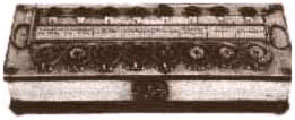Computing History Timeline
The Pascaline
In 1642, a 19 year old French mathematician named Blaise Pascal built the mechanical adding machine called the Pascaline. Blaise Pascal originally built this machine to assist his father, who worked as a tax commissioner, and sought to produce a device which could reduce some of his workload. By 1652 Pascal claimed to have produced some fifty prototypes.
The Pascaline is 36 cm, 13 cm wide and 8 cm high. Pascaline has the size of a shoe box. The surface is metal. There are eight windows on the top of it. Inside each of the windows, one can see a small drum with the result digits designed on it. Each drum has two rows of numbers. One black row under one red row. The black row of numbers is dealing with addition and the red row is dealing with subtraction. Every time that an addition is taking place one horizontal slat is covering the red row of the numbers. The black row of numbers is being covered when one wants to make a subtraction. In front of the windows there are eight setting mechanisms. Those mechanisms help the user enter the number that he wants to compute. They have the appearance of a wheel. The spokes of the wheels are turning around the axle of the wheel. The periphery of the wheel is attached on the machine and it is inscribed with the digits. The first wheel from the right has twelve spokes, the second has twenty, and the rest of the wheels have ten spokes each. The first wheel serves for adding the derniers, the second for adding the sols and the rest of the wheels to add the livres (at that time the system of English currency was still in use in France). If someone wants to add numbers which serve purposes other than the national currency of France, then he has to use only the six left wheels of the machine.
Although Pascaline was designed for adding French livers, Pascal also designed machines that they don't have setting mechanisms for the derniers and the sols, machines that are adding five digit numbers, six digit numbers and eight digit numbers. Depending on the place value of the amount to be added, the wheels were to be moved by as many tooth positions as corresponded to the value of the digit concerned. This turned the gears in the interior of the machine and caused the resultant sum to appear in the windows. Depending on the place value of the amount to be added, the wheels were to be moved by as many tooth positions as corresponded to the value of the digit concerned. This turned the gears in the interior of the machine and caused the resultant sum to appear in the windows. The initial prototype of the Pascaline had only a few dials, whilst later production variants had eight dials, the latter being able to deal with numbers up to 9,999,999.

Pascaline is not a calculating machine, but actually just an adding machine. In fact all similar machines with stylus setting mechanisms should be called adding machines rather than calculating machines. Despite all that Pascaline was a historical achievement and it is considered today as the first calculating device that the human race has discovered.
By Alex Chan

